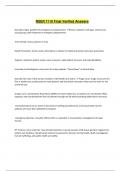NSER 7110 Final Verified Answers
Describe unique qualities of emergency nursing practice. ✅Diverse: patients of all ages, cultural and
social groups seek treatment in emergency departments.
Time-limited: assess patients in crisis
Health Promotion: look to share information in relation to health promotion and injury prevention
Urgency: related to patient acuity, scare resources, rapid patient turnover, and unpredictability.
Uncertain and Ambiguous: entry point for many patients, "found down" in back of alley.
Describe the roles of the various members of ED health care teams. ✅Triage nurse: triage nurses are the
first in health care professionals to meet patients and that initial interaction often sets the tone for the
entire ED visit.
charge nurse: aka Assistant Head Nurse (AHN), the team leader (TL), or patient care coordinator (PCC)
organizes and coordinated the flow of patients through the ED while providing leadership to the team.
Licensed practical nurse: works in fast track or walking wounded area, and may provide care for
patients who have been admitted to hospital.
emergency physician: Causality officer (CO), is a specialist in resuscitation, management of major
trauma
RT. Forensic nurse examiner: may provide expertise in sexual assaults, child abuse, geriatric neglect and
patient care facilities, interpersonal violence issues/events, forensic mental health, death investigation,
human trafficking, and public health and safety.
,Geriatric emergency nurse (GEN): advanced practice nurse who identifies geriatric issues, assists elderly
patients in navigating the health-care system, and aids in planning for safe patient discharges. Nurse
practioner: NP.
Analyze the socio-political factors that influence the current state of EDs. ✅--> Vast cuts to health care
services over the past thirty years have resulted in the ED acting as the gate keeper for a large portion of
acute care services.
--> A key role of ED health care professionals is to provide unbiased care to everyone who presents.
--> These "marginalized" or "at risk" populations are amongst the most vulnerable in our society for
several reasons; they may have chronic diseases, a lack of support systems, and/or limited financial
resources.
1. explain common, emergent conditions that present with the symptom of abdominal pain. ✅Tension
pain (visceral pain, vague, deep, and poorly localized)
Gastroenteritis (due to irritating foods or infection), constipation (increased forcefulness of contraction,
around obstructing contents), and acute pancreatitis (stretching of an organ capsule), typically produce
the clinical picture of a patient who cannot get comfortable. The patient shifts position several times
during the course of the examination in an effort to find the most comfortable position.
Inflammatory pain (type C fibers, pain is initially perceived as vague, deep and difficult to localize).ex:
appendicitis. the pain of appendicitis is described by the patient as midabdominal or periumbilical. As
the visceral peritoneum inflames, the symptoms remain vague and general, much like the tension pain
described previously. However, within several hours, the inflammation extends to involve the parietal
peritoneum, and the patient begins to localize the pain more readily, typically to the right lower
quadrant.
Ischemic Pain: Ischemic pain is the third of the visceral pain types, and is the least common but the most
serious. Identifying ischemic pain patterns is important in terms of avoiding serious and fatal
consequences. Fortunately, when symptomatic, ischemic pain presents as typical ischemic pain does in
any other portion of anatomy. It is sudden in onset, intense, continuous, and progressive. An additional
diagnostic clue is that, unlike other forms of abdominal pain, it is not relieved with analgesia.
,outline the concept of "level of urgency" in relation to ED nursing practice. ✅Stable patients present
with normal clinical findings and a history leading to admission that is not life or limb threatening.
Unstable patients present with abnormal clinical findings and a history that is considered life or limb
threatening.
A third category of LOU needs to be considered for all stable patients. Potentially unstable patients may
present with normal clinical findings but their history leading to admission warrants concern and
ongoing observation. The patient could deteriorate if proper intervention is not taken.
CTAS levels: ✅Level 1 - Resuscitation
Level 2- Emergent
Level 3 - Urgent
Level 4 - Less Urgent
Level 5 - Non-urgent
Secondary Assessment ✅1. subjective history (also known as the "history of presenting illness" or "the
story"
2. Objective assessment (also known as the "head-to-toe"
3. Focused system assessments
Primary Assessment ✅C - identify need for CPR or need to control major bleeding
A - Airway and C-spine control
B - breathing
C - Circulation
D - Disability, Doctor, Dextrose, Discomfort
E - Expose
F - Full set of vitals signs and family presence
, G - Go back and re-assess
H - subjective history, objective assessment (head-to-toe), focused system assessment
J - Journey
C - assessment and intervention ✅Assessment:
- need for CPR
- uncontrolled bleeding
Interventions:
- CPR- start BLS/ACLS/PALS
- control bleeding
A - Airway and C-spine ✅Assessment:
- look , listen and feel for air-movement
- clarity of speech
- Patency verses obstructions = stridor, gasping, wheezing, snoring, drooling, gurgling
- AVPU
- C-spine injury in trauma
Interventions:
- clear oropharynx with suctioning
- jaw thrust/chin lift
- oral/nasopharyngeal airway
- consider/prepare for advanced airway
- Spinal Motion Restriction (SMR)
Breathing - Assessment and Intervention ✅Assessment:
- rate, effort, and quality of respirations (diminished or absent), retractions, accessory muscle use, nasal
flaring, head-bobbing, grunting.




